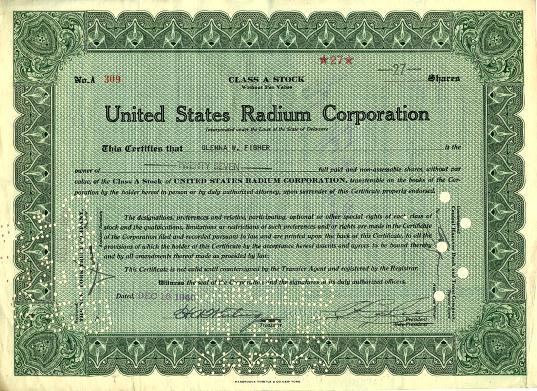

#American radium orange nj license
Such sources may be possessed under a general license however, if the source strength exceeds 0.037 megabecquerels (1.0 microcurie), a specific license will be required. Sources of this type have been used as operational check sourcesįor radiation measuring instruments, educational demonstration equipment (e.g., cloud chambers and spinthariscopes), electron tubes, lightning rods, ionization sources, static eliminators, and other approved uses. A small radium source is defined inġ0 CFR 31.12(a)(5) as containing an amount of radioactivity of 0.037 megabecquerels (equivalent to 1.0 microcurie) or less. These sources are well above the “small source activity” for luminous antiquities. How did you you obtain a specific license to possess the unused Undark? The Energy Policy Act of 2005 made radium-226 in most forms a much more stringently regulated material, and it is retroactive. The surest measurement would be a calibrated HPGe reading of a Bi-209 peak at a carefully-controlled distance, but that’s more involved than I was able to go tonight. I still think the reading is high due to betas and bremsstrahlung and believe the vial content is closer to 20 microcuries each.

The Geiger measurement is within 20% of a calibrated Ludlum 9 ion chamber reading, beta window closed and centered on the same location. Using the Ra-226 equilibrium specific gamma constant, this suggests a content of 49 microcuries of Ra-226 in that vial. One of my vials measures 750 cpm on an energy-compensated HP-270 probe at 10″, corresponding to 0.63 milliroentgen / hr there. An NaI scintillator is gamma-sensitive, but the count rate depends critically on the detector’s threshold and the gain of the specific PMT at a specific operating voltage, and thus this isn’t a good comparison either. Hi Jack, the 44-9 is a pancake tube mostly sensitive to beta particles, and since betas are strongly attenuated in the source and its packaging, this wouldn’t be too meaningful a measurement unless both sources had very similar packaging. In order to make certain that it will become insoluble and also that it will be equally distributed in the paste and also to prevent the radium element from being dissolved later when water is applied to it, I converted the radium into radium sulphate which is insoluble by adding amount of ammonium sulphate also in an aqua solution.”

The radium element when mixed with the sulphide powder is soluble. When that is added to the zinc sulfide which is in the form of a dry powder, it becomes like a paste. The radium element when added to the zinc sulphide is in an aqua solution. von Sochocky, added a measured amount of radium to the base and fixed it in its insoluble sulfate form: “epending upon the type of work the material is to be used for the element of radium varied from one part of radium element to 140,000 parts of the base-zinc sulphide, to one part of radium element to 53,000 parts of the base. Another employee, originally company founder S. At the time of the “Radium Girls” poisoning, a single employee named Isabel manufactured a zinc sulfide base activated with trace quantities of cadmium, copper, and manganese. An article that was painted with this product was said to be “Undarked.” The formula of Undark varied with application and was a trade secret. Radium named its radioluminous paint Undark. (The same house can be seen in the background in both images.) I’ll share some quotes about the technical operation of this facility, and a pic of my samples of its product, Undark.
#American radium orange nj archive
In this post I’ll share a few photos from my trip this month, from the Library of Congress’s archive of the recent past, and even one from the plant’s heyday. Today, the site is a barren, fenced-in, field with no hint of radioactivity betraying its former capacity. Two original buildings-including the paint application building-remained standing until the US EPA had them torn down as part of a Superfund remediation project in 1998. This factory was built in 1917 for the combined purposes of radium extraction, purification, and paint application. Although a large number of radium paint factories existed, one in particular is identified with this infamous episode: the United States Radium Corporation, sited on two acres at the southwest corner of High and Alden Streets in Orange, New Jersey. Many people know the tragic story of the “radium girls,” the luminous-dial painters of the flapper era who tipped their paintbrushes in their mouths, became sickened from internal radiation exposure, and had to fight for workers’ compensation as they died.


 0 kommentar(er)
0 kommentar(er)
